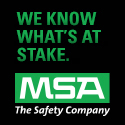BY ASHLEY SWINEHART
Safety should always be top priority on the jobsite. Construction professionals — crew members and foremen alike — must always have safety procedures and precautions in mind when it comes to daily functions. Everybody wants to feel safe at work, and for those around heavy machinery and moving objects during the day, achieving that can have its challenges. Here are a few tips and advice on how to keep it simple.
CRANE SAFETY
Operating a crane requires attentiveness and knowledge. When asked to provide advice to those considering the field or needing guidance, professional crane operators concluded that an operator's top three priorities while on the job are:
1. Know the Crane
Be aware of the specific crane's lift capacity, load chart, whether it is well-maintained, and which components are needed for its optimal operation.
Cranes are rated based on their load charts, which are specific to each crane and provided by the crane's manufacturer or the employing construction company. The purpose of rating a crane is to help a worker understand how heavy a load the crane can lift. Reading the load chart will help the operator determine the weight of the load that can be lifted by calculating the angle of the boom, extension length of the boom, and dimensions of the crane, including weight of counterweight. This chart should always be considered before beginning a job to avoid crane tip over or boom collapse.
2. Know the Load
Be knowledgeable of the load's weight and dimensions, whether ropes, chains, or wire are needed for lifting, and where its center of gravity is for rigging.
Cranes aren't the only pieces of equipment that need to be rated before lifting a load. Another thing to consider is the load capacity of the wire being used to hoist the load from the crane's boom. The wire and chain must be strong enough to lift the load to ensure neither snaps at any point during a lift.
3. Know the Jobsite
Have a clear idea of the objects, crew members, and overhead power lines within swing radius of the crane.
When working near electrical distribution and transmission lines, employers must make sure they are de-energized (electricity flow has been disconnected) and remain separate from the crane and its load. Doing so includes having a certified electrician shut off the electricity from the power supply located on the pole. It also includes maintaining a clearance between the crane and the power line. Using independent insulated barriers will prevent physical contact with overhead power lines. Also, maintaining a safe working clearance of at least 10 feet for 50kV (kilovolts) or less of electricity running through the electrical distribution lines and adding .4 inches for each additional kV will reduce likelihood of being electrocuted. Employers must designate a licensed electrician to make sure a crane and its load have safe clearance from overhead power lines. Cage-type boom guards, insulated lines, or proximity warning devices can be used, but are not considered substitutions for de-energizing and grounding lines or maintaining safe line clearances. Safety precautions should still be followed when using safety enhancement equipment such as the cage-type boom guards, insulated lines, and proximity warning devices.
By carefully considering the hazards of crane operation and the safety procedures used to combat them, operators and other crew members will help ensure their safety on the job.
WHAT TO WEAR ON SITE
Workers must always use proper personal protective equipment (PPE) relative to the task. They should carry a bag with their PPE inside and keep it in their vehicle to dress before entering a jobsite. All PPE should fit properly, be well maintained, and replaced if no longer effective. General PPE includes:
| PPE |
What it Protects |
| Safety goggles |
Eyes from dirt, flakes of metal and floating particle debris |
| Hard hat |
Head from exposure to falling objects |
| High-viz yellow vest |
Keeps you visible to others on the jobsite |
| Steel-toed boots |
Toes from falling objects or compression, and metal-plated mid-soles to protect from punctures |
| Ear plugs |
Inner ear (hearing) from loud noises and floating particle debris |
| Gloves (sanitary and work gloves) |
Hands from working with rough objects; coming in contact with toxic chemicals |
| Respirator |
Lungs from inhaling harmful vapors, dust fumes, or gases |
For more specific jobs, crew members may need specialized PPE. When working in close proximity to a body of water, a life jacket should be worn. If working with a service truck crane, a seat belt actually counts as PPE when on the road. Specialized PPE is important for operator tasks which may not be performed by other crew members. Therefore, even if operators have the basics, keeping PPE specific to their job will ensure that all tasks, no matter how diverse, will be completed the safest way possible.
A crane operator must be aware of his/her surroundings, knowledgeable about the crane, its condition, and load, and always utilize proper PPE. Environmental health and safety professionals on staff are always a great personal resource for one-on-one questions and concerns when it comes to health and safety on the jobsite. Following these guidelines and procedures will optimize a worker’s safety and minimize any chances of bodily injury or illness.

 2300 Wilson Boulevard, Suite 300 · Arlington, VA 22201 · 703-548-3118 (phone) · 703-548-3119 (fax) · www.agc.org
2300 Wilson Boulevard, Suite 300 · Arlington, VA 22201 · 703-548-3118 (phone) · 703-548-3119 (fax) · www.agc.org
 OSHA Announces Summer 'Construction Incident Prevention Initiative' in Region III
OSHA Announces Summer 'Construction Incident Prevention Initiative' in Region III
